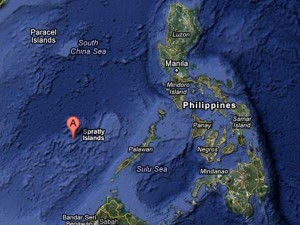PUERTO PRINCESA CITY—A fleet of 20 Chinese fishing vessels believed to be escorted by at least two naval frigates of the People’s Liberation Army has been deployed around Pag-asa Island in a move likely to escalate tensions over disputed territories in the Spratly archipelago between the Philippines and China.
Highly placed sources in the Philippine military reported that at least 20 Chinese fishing vessels had congregated about 9 kilometers (5 nautical miles) from Pag-asa beginning late Tuesday.
The fishing vessels were accompanied by two naval frigates of China’s People’s Liberation Army, according to one source who asked not to be identified for lack of authority to speak on the matter.
Colonel Neil Estrella, spokesperson of the Western Command, confirmed the Chinese presence near Pag-asa but declined to give details. He said the Department of Foreign Affairs (DFA) would address the latest development in the territorial dispute in the West Philippine Sea (South China Sea).
“We will let the DFA address that. But yes, Chinese vessels are there around the island,” Estrella told the Philippine Daily Inquirer by phone on Wednesday.
A source at the Naval Forces West based here said that at least four Philippine Navy and Coast Guard vessels were patrolling the Philippine-claimed territories in the Spratlys.
But like Estrella, the source declined to say how the Navy would respond to a Chinese intrusion into Philippine waters.
Pag-asa Island, which measures 32.7 hectares, is located 480 km off southwestern Palawan. The largest of five islands and islets in the Spratlys being claimed by the Philippines, Pag-asa has a 1.3-km airstrip used by the Philippine military to transport troops and supply.
Declared in the late 1970s as a municipality, Pag-asa has a census population of 150 and a kindergarten school for children of some 50 families residing there.
Staging ground
The Chinese presence was also confirmed by Mayor Eugenio Bito-onon of Kalayaan municipality, which includes Pag-asa.
A military source said the Armed Forces of the Philippines believed that the Chinese-occupied Mischief Reef was being used as the staging ground for the stepped-up presence of China inside Philippine territory.
China occupied Mischief Reef in 1995, amid protests from the Philippines and the Association of Southeast Asian Nations (Asean). Beijing then said that it was constructing a shelter there for fishermen.
Recent photos taken by Philippine naval surveillance planes showed Mischief Reef had been turned into a highly fortified garrison, with gun embankments on elevated towers.
Bito-onon said that Filipino fishermen who had approached Mischief Reef recently by bartering sea turtles for Chinese goods reported that the Chinese had dredged portions of the reef ostensibly to allow larger ships into the lagoon within the reef system.
“That entire area measures around 9 by 6 km with a wide east to west clearance suitable for entry of large vessels,” he said.
Harvesting corals
Bito-onon, interviewed while in Puerto Princesa City, reported “frequent sightings since last week of the Chinese fishing party on the eastern side of the island.”
The mayor said it was unclear from the report he received yesterday from administrative personnel on the island whether the fishing fleet was part of the armed fishing party dispatched by Beijing last week to the Paracels, an area disputed by China and Vietnam.
“We don’t know if they are accompanied by warships but for us, it appears to be a coral-gathering expedition by Chinese commercial fishers,” he said.
Bito-onon explained that Chinese fishers were frequently observed collecting large amounts of corals in the unprotected areas of the Philippines.
The corals, he said, were more valuable than fish “as they are sold in Hainan as some kind of raw material for the manufacture of a type of marine glue.”
Bito-onon said the Chinese were also developing Subi Reef near Pag-asa into another fortress. He said that the Chinese completed in May the construction on a half-submerged reef of a four-story building with a dome-shaped radar on its deck.
Recent aerial photos of Subi taken by the Western Command, copies of which were obtained by the Inquirer, showed a “landing ship” type vessel anchored in the inner portion of the reef.
Bito-onon said the Pag-asa residents did not feel physically threatened by the reported Chinese presence. He said he expected the vessels to depart after fishing and harvesting corals.
“Our staff have been observing their movements since last week. What we know is that the Chinese armed vessels were merely passing through on their way to Subi Reef. I don’t think they are staying put there,” he said.
Opposite side is Vietnam’s
Bito-onon, however, expressed concern about the “coral mining” activities. “They are there not primarily to fish. We think they are mainly engaged in gathering corals which is a more lucrative business in Hainan,” he said.
He explained that the corals were used by the Chinese as base ingredient for some type of marine glue used in shipbuilding. In the last two weeks, he said several Chinese boats had been gathering corals around the area.
Bito-onon also claimed that the Chinese vessels were congregating near Pag-asa “because on the opposite side are the Vietnamese in Southwest Cay and they have gun emplacements there.”
“They prefer to anchor near Pag-asa because they are not safe on the Vietnamese side of the passage where there are large cannons pointed toward the sea,” he added.
Originally posted at 08:54 pm | Wednesday, July 25, 2012


